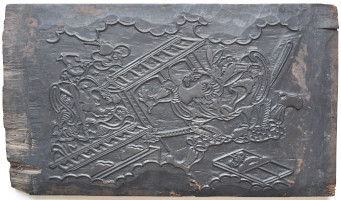/category/warriors-and-legends/page/9/
Tsukioka YOSHITOSHI (1839-1892)

Click here to view image full size.
Faith in the Third-day Moon from the set Tsuki hyakushi, the “Hundred Phases of the Moon.” The set published between 1885 and 1892 (this being 1886) by Akiyama Buemon. Shows the standing figure of the samurai Yamanaka Shikanosuke Yukimori. The moon appears both as a half crescent on his helmet, and also on his kamayari, “sickle spear.” The crescent moon was considered a lucky emblem (mikazuki) and Yukimori believed it would bring him good luck in battle
Very fine impression of the earliest printing with beautiful gradation around the figure – often missing on late editions. The set was popular and many editions were printed and many late impressions exist. Great care was taken with the cutting of the blocks on this set and only early impressions do them justice. Fine colour. Light backing and slight trimming at left, otherwise fine condition. Signed Yoshitoshi.
Status: Sold
Tsukioka YOSHITOSHI (1839-1892)

Click here to view image full size.
Saito no Oniwakamuru from the set Ikkai zuihitsu, “A Miscellany by Ikkai.” (This being an early name of Yoshitoshi’s.) The young Saito Musashibo Benkei was given the moniker Oniwakamuru “Devil Child” because of his feats of strength and general behaviour. The episode depicted here, which was a popular theme for artists, shows the young Oniwakamaru battling a giant carp at the Bishamon Waterfall, where he has gone looking for his mother, Ohaya. On killing the carp, he discovers it has eaten his mother. A set published by Masadaya Heikichi, 1872-3 (this being 1872). Even amongst Yoshitoshi’s best work, this is an outstanding design.
Very fine impression of the first edition. Fine colour and condition. Signed Ikkaisai Yoshitoshi hitsu.
Status: Sold
Tsukioka YOSHITOSHI (1839-1892)

Click here to view image full size.
Shows the famous Heron Maiden. There are different versions of this story but the most common tells how a young man finds an injured heron. He nurses it back to health and releases it. Some time later a beautiful young woman appears in his village. He falls in love and they marry. She makes fine brocade which they sell, but she does not allow him to see her making it. Tempted , he secretly views her only to discover she is the heron. This is the end of their marriage and the heron flies away. From the set Shingata sanjurokkaisen, “New Forms of Thirty-six Ghosts,” subtitle: Sagi-musume. The set published by Sasaki between 1889-1892 (this being 1889). This is the first edition.
Very fine impression, colour and condition. Signed Yoshitoshi.
Status: Sold
Tsukioka YOSHITOSHI (1839-1892)

Click here to view image full size.
Musashino no tsuki, “The Moon on Musashi Plain” from the set Tsuki hyakushi, the “Hundred Phases of the Moon.” The set published between 1885 and 1892 (this being 1892) by Akiyama Buemon. One of the three best designs from the set and one that relies most on the printer’s art – using extensive bokashi. The fox was capable of transmogrifying into human form and vice versa and was popular in Japanese folklore.
Very fine impression with beautiful gradation of the earliest printings on the grasses around the fox. (See Beauty & Violence, 1992, 54.97, p. 75 for an example of the more prosaic later printing.) The set was popular and many editions were printed and many late impressions exist. Great care was taken with the cutting of the blocks on this set and only early impressions do them justice. Fine colour and condition. An impression that has not been in an album. Full margins. Signed Yoshitoshi.
Status: Sold
Tsukioka YOSHITOSHI (1839-1892)

Click here to view image full size.
A fox priest from the set Tsuki hyakushi, the “Hundred Phases of the Moon.” The set published between 1885 and 1892 (this being 1886) by Akiyama Buemon. Based on the Kyogen farce Konkai, “A Foxe’s Cry” which tells of a hunter who is lectured on trapping foxes by his uncle, a priest. On his way home his uncle turns into his true form, a fox, and is snared in a trap. Yoshitoshi’s design shows the uncle transmogrifying into a fox. One of the best designs from the set.
Fine impression and colour from an early printing. The set was popular and many editions were printed and many late impressions exist. Great care was taken with the cutting of the blocks on this set and only early impressions do them justice. Fine colour and condition. An impression that has not been in an album. Full margins. Signed Yoshitoshi.
Status: Sold
Utagawa KUNIYOSHI (1797-1861)

Click here to view image full size.
Saginoike Heikuro from Honcho Suikoden goyu happyaku-nin no hitori, “Eight Hundred Heroes of our Country’s Suikoden, One by One.” Shows the brigand wrestling with a huge serpent at the Lake of Sayama (or Hazama) at Tondabayashi in the Province of Kawachi. Published by Ibaya Sensaburo, c 1845. (First issued by Kaga-ya Kichiyemon, c 1831, his seal just visible lower right corner.) Robinson S4b.4. A fine design.
Very good impression and colour. Full size. Slightly soiled bottom left, otherwise very good condition. Signed Ichiyusai Kuniyoshi ga.
Status: Sold
Utagawa KUNIYOSHI (1797-1861)

Click here to view image full size.
Kyusempo Sakucho (Chin: Suo Chao) at the battle of Peking from Tsuzoku Suikoden goketsu hyaku-hachi-nin no hitori, “The Hundred and Eight Heroes of the Popular Suikoden, One by One.” Based on the Chinese novel Shui Hu Zhuan, attributed to Shi’Nai’an, which tells of a band of 108 brigands who operated from Liangshan Marsh. Shows the warrior wielding a huge axe and plunging through deep snow on his horse. He was renowned for being seven chi tall (just over seven and a half feet) and impetuous in battle, often charging ahead of his men – hence his nickname “Impatient Vanguard.” Published by Kaga-ya Kichiyemon, c 1827-30. Provenance: Ex B.W. Robinson collection. Robinson S2.44.
Fine impression, colour and condition. Full size (rare with designs from this set). Signed Ichiyusai Kuniyoshi ga.
Status: Sold
Utagawa KUNIYOSHI (1797-1861)

Click here to view image full size.
The warrior Hitentaisei Rikon (Chin: Li Gun) in armour and holding a hand spear (nage-yari) the use of which he excelled at. He scans the horizon from a craggy outcrop. From the set Tsuzoku Suikoden goketsu hyaku-hachi-nin no hitori, “The Hundred and Eight Heroes of the Popular Suikoden, One by One.” Based on the Chinese novel Shui Hu Zhuan, attributed to Shi’Nai’an, which tells of a band of 108 brigands who operated from Liangshan Marsh. Published by Kaga-ya Kichiyemon, c 1827-30. Robinson S2.21.
Fine impression, colour and condition. Full size (rare with designs from this set). Signed Ichiyusai Kuniyoshi ga.
Status: Sold
Utagawa KUNIYOSHI (1797-1861)

Click here to view image full size.
Shows the warrior Chinsanzan Koshin (Chin: Huang Xin) holding the “Sword of Death.” His nickname was the “Guardian of the Three Mountains” because of his boast that he could easily eradicate the bandits from the three mountains in the Qingzhou region. . From the set Tsuzoku Suikoden goketsu hyaku-hachi-nin no hitori, “The Hundred and Eight Heroes of the Popular Suikoden, One by One.” Based on the Chinese novel Shui Hu Zhuan, attributed to Shi’Nai’an, which tells of a band of 108 brigands who operated from Liangshan Marsh. Published by Kaga-ya Kichiyemon, c 1827-30. Robinson S2.10.
Fine impression, colour and condition. Full size (rare with designs from this set). Signed Ichiyusai Kuniyoshi ga.
Status: Sold
Utagawa KUNIYOSHI (1797-1861)

Click here to view image full size.
Shows the fearsome female warrior, Fujinoye, defending Takadachi Castle in 1189. In a rain of arrows she attacks Yemoto Juro and Nagasawa Uyemon-taro on the castle steps. From the set Honcho Suikoden goyu happyaku-nin no hitori, “Eight Hundred Heroes of our Country’s Suikoden, One by One.” Published by Kaga-ya Kichiyemon, c 1831. Robinson S4a.1.
Fine impression and colour. Slight trimming at bottom, otherwise very good condition. Signed Ichiyusai Kuniyoshi ga.
Status: Sold
Utagawa KUNIYOSHI (1797-1861)

Click here to view image full size.
Shows Sasaki Saburo Moritsuna, holding a dirk in his mouth, and strangling the fisherman Fujidayu. From an untitled set published by Kawaguchi-ya Uhei, c 1825-30. The story revolves around Moritsuna bribing the fisherman to reveal the whereabouts of the shallows at Fujito, a strait separating Kojima from the mainland, and being 500 yards wide impossible for the troops to cross without boats to attack the Taira forces. The version depicted here shows Fujidayu being killed, rather than just bribed. Robinson Sia.6.
Fine impression, colour and condition. Signed Ichiyusai Kuniyoshi ga.
Status: Sold
Tsukioka YOSHITOSHI (1839-1892)

Click here to view image full size.
A triptych Gikeiki Gojobashi no zu, “Gojo Bridge in the Chronicles of Yoshitsune.” Shows Musashi-bo Benkei of herculean strength subdued by the young Onzoshi Ushiwaka Maru (Yoshitsune) on Gojo Bridge.The story relates how Benkei (1155-1189) wandered around Kyoto with the intention of relieving 1000 samurai of their swords. One night, with one more sword to go, he saw Yoshitsune playing a flute and wearing a golden sword at the Gojotenjin Shrine. They agreed to fight on Gojo Bridge in southern Kyoto. However, Yoshitsune was too agile for Benkei and had been educated in the secrets of fighting by the tengu. Following Yoshitsune’s victory Benkei became Yoshitsune’s retainer. Published by Morimoto Junzaburo, 1881. One of Yoshitoshi’s best designs.
Very good impression and colour. Later editions lack the black outline around the moon and have clouds added. (Interestingly, a feature usually found on the earliest states of prints, but in this case the reverse.) Very good condition. Signed Taiso Yoshitoshi ga.
Status: Sold
Tsukioka YOSHITOSHI (1839-1892)

Click here to view image full size.
A triptych showing the Japanese Buddhist deity Fudo Myo-o, one of the five “Kings of Wisdom,” above the novitiate priest Yuten Shonin (1637-1718) about to consume the sword of wisdom thereby gaining supernatural wisdom and enlightenment. (Often miscatalogued as threatening him.) On the right is the goddess of mercy, Kannon. The scene is set in the Zojoji Temple where Shonin goes on to become the Abbot. Published by Akiyama Buemon, 1885.
Fine impression with the publisher’s details intact in the left border of last sheet – often trimmed off. Fine colour and condition. Signed Yoshitoshi.
Status: Sold
Utagawa KUNIYOSHI (1797-1861)

Click here to view image full size.
The best design from a set of half-length otokodate figures: Kuniyoshi moyo shofuda tsuketari genkin otoko, “Men of Ready Money with True Labels Attached, Kuniyoshi Fashion.” Here showing Danshichi Kurobei emptying a bucket of water over himself. Danshichi was a fishmonger in the city of Sakai who murdered somebody in the mid-winterof 1697, the body only being discovered when the snow melted. He is often depicted pouring water over his head, although there are also versions where he commits the crime in a swamp. Published by Ibaya Kyubedi, 1845. Poem by Hoshitei.
Very good impression and colour. Slight trimming, otherwise very good condition. Signed Ichiyusai Kuniyoshi ga.
Status: Sold
Tsukioka YOSHITOSHI (1839-1892)

Click here to view image full size.
Tamiya Boutaro from a set Kokoku nijushiko, “The Twenty-four Accomplishments in Imperial Japan.” Shows the spirit of the tengu helping Tamiya Boutaro Munechika avenge his father’s death. The set published by Tsuda Genshichi 1881-87 (this being 1881).
Fine impression: This is the first edition. It was republished by Matsuki Heikichi with altered signatures and other changes and inferior printing. Fine colour and condition. Signed Oju Yoshitoshi ga.
Status: Sold
An original BLOCK (c. 1715)
An original double-sided wood block, c. 1715. This is the earliest block I have catalogued or indeed seen. Shows warriors in combat on one side and on the reverse a samurai and attendant approaching a beauty on a balcony. Sold “as is” with all imperfections. Rare.
Status: Sold
Utagawa KUNIYOSHI (1797-1861)

Click here to view image full size.
The priest Nichiren standing on a rocky promontory at Reizen in Kamakura and having his prayers for rain answered. The event occurred in 1271. His disciples surround him and protect him from the deluge with a large umbrella. Bunei hachi Kamakura Reizan-ga-saki uki. The second best design from Koso [Nichiren] goichidai ryakuza, “Illustrated Abridged Biography of the Founder.” Nichiren (1222-1282) was the founder of the Buddhist Nichiren sect (Nichiren shu – Kuniyoshi being a follower) and indeed the set of ten prints may have been commissioned to mark the 550th anniversary of his death. Published by Iseya Rihei c. 1831.
Fine impression. This example has an orange-red colour used on Nichiren’s robe and umbrella rather than the brighter red of other impressions. Very good colour and condition. Full size with ample room on top border for the umbrella which protrudes beyond the border and is notorious for being trimmed. Signed Ichiyusai Kuniyoshi ga.
Status: Sold
Kobayashi KIYOCHIKA (1847-1915)

Click here to view image full size.
A triptych, Akechi Samanosuke Mitsuhara kosui joho Karasaki matsu no zu. Shows Akechi Samanosuke Mitsuhara swimming with his horse and with his kikyo (Chinese bell flower) standard tied to his back across Lake Biwa to his cousin’s house at Sakamoto where he kills Mitsuhide’s wife and children to prevent them being captured. The Karasaki pine can be seen in the background. The event takes place in 1582. One of Kiyochika’s best designs. Published 1899.
Very fine impression. Fine colour and condition. Signed Kiyochika hitsu.
Status: Sold
Tsukioka YOSHITOSHI (1839-1892)

Click here to view image full size.
A vertical diptych Shunkan sozu Kikaigashima ni oite tamatama Yasuyori no shamen sembo kito no zu. Shows Shunkan watching a boat sail away from Kikai Island with his pardoned compatriots. Shunkan, the abbot of the Zen temple Hoshoji in Kyoto, was exiled to the barren island of Kikaigashima together with two confederates in 1177 for conspiring against Taira no Kiyomori. The following year Kiyomori pardons political prisoners but omits Shunkan. He is seen here beseeching the boat with his two conspirators to return. Published by Matsui 1886.
Fine impression of first state. Fine colour with splashed gofun and blind-printing. Fine condition with ample room for joining the two sheets. Signed Yoshitoshi.
Status: Sold
Utagawa KUNISADA (1786-1865)
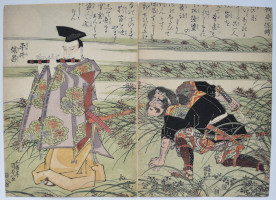
Click here to view image full size.
A very early and extremely rare diptych showing Hakamadare Yasusuke and Hirai no Yasumasa. A famous story depicted many times by other artists during the following century. The story relates how Yasumasa, an accomplished flautist, is playing his flute one evening on Ichihara moor. Unknown to him, the villain Hakamadare Yasusuke is creeping up to steal his sumptuous robe. At the last minute Yasusuke is so captivated by the beauty of the music that he abandons his plan. It turns out he is Yasumasa’s brother and is given a fine set of robes. Published by Iseya Rihei (Kinjudo) c. 1815.
Very good impression and colour. Trimmed round. Signed Gototei Kunisada ga.
Status: Sold
Suzuki HARUNOBU (1724-1770)

Click here to view image full size.
A pillar print showing a young dandy holding an Odawara lantern on entering a Shinto shrine. One leg of the Torii is in the background behind a hinoki tree. Another impression is illustrated in The Japanese Pillar Print, Hashira-e, Jacob Pins, Robert G. Sawers publishing, 1982, 184a, p. 118 which also shows a variant impression with a night sky, 184b.
Very good impression. Good colour for a pillar print: This format is notorious for fading and browning. Very good condition. Signed Suzuki Harunobu ga.
Status: Sold
Katsukawa SHUNTEI (1770-1820)

Click here to view image full size.
A triptych showing the killing of the giant Earth Spider in its cave. These Tsuchigumo were a form of spider-like yokai. Minamoto no Yorimitsu’s (aka Raiko, 948-1021) retainers (The Four Heavenly Kings) are shown holding the spider down with the trunk of a large tree: Sakata no Kintoki, on first sheet, Watanabe no Tsuna, in the centre, and Urabe no Suetake and Usui Sadamitsu on last sheet (on the left). It is said that when the spider was killed that 1990 dead victims emerged from its stomach. This was a popular story covered by many artists. Published by Enomotoya Kichibei, c. 1808. Rare.
Very good impression and colour. Small backed binding holes, otherwise very good condition. Signed Shuntei ga.
Status: Sold
Utagawa KUNIYOSHI (1797-1861)

Click here to view image full size.
A triptych showing Fujiwara no Hidesato being accompanied by a retinue of fish, octopuses and lobsters as he leaves the Dragon King’s Palace with the presents of inexhaustible rice, bolts of cloth, and a bell in gratitude for killing the centipede of Mount Mikami. Ryugujo Tawara Toda Hidesato ni sanshu no tosan o okura. Published by Maruya Kyushiro, 1858.
Very good impression. Good colour. Some light toning and soil. Signed Ichiyusai Kuniyoshi ga.
Status: Sold
Taiso YOSHITOSHI (1839-1892)

Click here to view image full size.
Kobayakawa Takakage debating with the tengu on mount Hiko from Shinkei sanjurokkaisen, “New Forms of Thirty-six Ghosts.”The set published by Sasaki Toyokichi, 1889-1892 (this being 1892).
Very fine first edition. Fine colour and condition. Signed Yoshitoshi.
Status: Sold
Tsukioka YOSHITOSHI (1839-1892)

Click here to view image full size.
Shows Asahina Saburo Yoshihide, the fabled warrior of superhuman strength, subjugating the King of Hell, Ema-o. He forces him to indicate the path to Heaven. This episode is from the kabuki play Asahina. From the set Ikkai zuihitsu, “Essays by Yoshitoshi.” (Ikkai was an early name of Yoshitoshi’s.) A set of thirteen prints published by Masadaya Heikichi 1872/3. A fine set.
Extremely fine impression and colour from the first edition. Most designs from the set have red seals in the margin and red seals over the signature. These were removed on later editions. Margins trimmed a little, otherwise fine condition. Signed Ikkaisai Yoshitoshi hitsu.
Status: Sold
Tsukioka YOSHITOSHI (1839-1892)

Click here to view image full size.
Shows the famous episode from the Edo novel Nanso Satomi hakkenden “Chronicles of the Eight Dog Heroes of the Satomi Clan of Nanso.” Two of the heroes Inuzuka Shino and Inukai Kempachi fall from the rooftop of Horyukachu Tower, Koga Castle, still grappling with each other and scattering pigeons as they descend into the Tone River. From the set Ikkai zuihitsu, “Essays by Yoshitoshi.” (Ikkai was an early name of Yoshitoshi’s.) A set of thirteen prints published by Masadaya Heikichi 1872/3. A fine set.
Extremely fine impression and colour from the first edition. Most designs from the set have red seals in the margin and red seals over the signature. These were removed on later editions. Margins trimmed a little, otherwise fine condition. Signed Ikkaisai Yoshitoshi hitsu.
Status: Sold
Tsukioka YOSHITOSHI (1839-1892)

Click here to view image full size.
Shows the famed warrior Sanada Saemon-no-jo Yukimura (in fact Nobushige) crouching down amongst giant lotus plants, holding a rifle, in order to ambush Tokugawa Ieyasu during the siege of Osaka castle. Initially, Yukimura was a follower of Ieyasu but was betrayed by having his land seized and so switched sides. He won many battles in which his army was outnumbered. From the set Ikkai zuihitsu, “Essays by Yoshitoshi.” (Ikkai was an early name of Yoshitoshi’s.) A set of thirteen prints published by Masadaya Heikichi 1872/3. A fine set.
Extremely fine impression and colour from the first edition. Most designs from the set have red seals in the margin and red seals over the signature. These were removed on later editions. Margins trimmed a little, otherwise fine condition. Signed Ikkaisai Yoshitoshi hitsu.
Status: Sold
Tsukioka YOSHITOSHI (1839-1892)
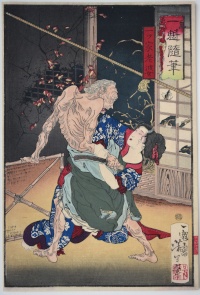
Click here to view image full size.
Shows the cannibalistic old hag of Adachi Moor attacking a young woman. There are various versions of this macabre story but the central theme is that she needed to collect blood, usually from unborn children, either for herself or as a remedy for her sickly lord. From the set Ikkai zuihitsu, “Essays by Yoshitoshi.” (Ikkai was an early name of Yoshitoshi’s.) A set of thirteen prints published by Masadaya Heikichi 1872/3. A fine set.
Extremely fine impression and colour from the first edition. Most designs from the set have red seals in the margin and red seals over the signature. These were removed on later editions. Margins trimmed a little, otherwise fine condition. Signed Ikkaisai Yoshitoshi hitsu.
Status: Sold
Tsukioka YOSHITOSHI (1839-1892)
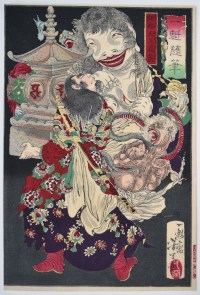
Click here to view image full size.
Shows Chao Gai (Jap. Takuto Tenno Chogai), the Heavenly King and Suikoden hero, lifting a stone pagoda which releases a Pandora’s box of gruesome spirits: An enormous white figure with a face on its abdomen, various oni and a brown spirit, its chest holding a twisting snake. From the set Ikkai zuihitsu, “Essays by Yoshitoshi.” (Ikkai was an early name of Yoshitoshi’s.) A set of thirteen prints published by Masadaya Heikichi 1872/3. A fine set.
Extremely fine impression and colour from the first edition. Most designs from the set have red seals in the margin and red seals over the signature. These were removed on later editions. Trimmed on black border at left, otherwise fine condition. Signed Ikkaisai Yoshitoshi hitsu.
Status: Sold
Tsukioka YOSHITOSHI (1839-1892)

Click here to view image full size.
Yodo-no-Kimi (aka Yodogimi), the concubine and second wife of the daimyo Toyotomi Hideyoshi, readies herself for seppuku: Hideyoshi, having died, she and her son are thought to pose a threat to Tokugawa Ieyasu who had become a guardian of Hideyoshi’s son. They hold up in Osaka castle where they commit suicide, rather than be captured. From the set Ikkai zuihitsu, “Essays by Yoshitoshi.” (Ikkai was an early name of Yoshitoshi’s.) A set of thirteen prints published by Masadaya Heikichi 1872/3. A fine set.
Extremely fine impression and colour from the first edition. Most designs from the set have red seals in the margin and red seals over the signature. These were removed on later editions. Margins trimmed a little, otherwise fine condition. Signed Ikkaisai Yoshitoshi hitsu. d on later editions. Trimmed on black border at left, otherwise fine condition. Signed Ikkaisai Yoshitoshi hitsu.
Status: Sold
Utagawa KUNIYOSHI (1797-1861)

Click here to view image full size.
The last stand of the Kusunoki at Shijonawate in 1348. The battle between Ko no Moronao of the Northern Court and Kusunoki Masatsura of the Southern Court. Shows the warriors Genshu, Masatsura and Masatomo in a hail of arrows. Masatsura dies at the tender age of 22. This forms a hexaptych design with a triptych on the left. Published 1857 by Sagamiya Tokichi (Ai-to). A fine design.
Extremely fine impression of what must be the earliest printing. Fine colour with gum added to the areas of blood. Small backed binding holes, otherwise fine condition. Signed Ichiyusai Kuniyoshi ga.
Status: Sold
Utagawa KUNIYOSHI (1797-1861)

Click here to view image full size.
Sasai Kyuzo Masayasu enveloped in smoke and avoiding musketry at the battle of Anegawa. The best design from the set Taiheiki yeiyuden, “Heroic Stories of the Taiheiki.” A history of the wars of the loyalist Nitta and Kusunoki families against the Ashikaga war-lords during the second quarter of the 14th century. But in fact the subject of this set of fifty prints is the civil war of the late 16th century. Censorship restrictions imposed in the 1840s prevented publishers from illustrating historical subjects from the Tensho era 1573-92 onwards, so the publishers circumvented this by slightly altering the names of the historical figures. Published 1848-9 by Yamamoto-ya Heikichi. Robinson S62.36.
Fine impression and colour. Very good condition. Signed Ichiyusai Kuniyoshi ga.
Status: Sold
Utagawa KUNIYOSHI (1797-1861)

Click here to view image full size.
Shows Hatsuhana’s long penance under the Tonozawa waterfall to aid her crippled husband “Hazari” Katsugoro who is intent on revenging his brother’s murder. Hatsuhana dies, Katsugoro is cured and kills his arch enemy near the waterfall. From the set Kenjo reppuden, “Stories of Wise and Virtuous Women.” Published by Ibaya Sensaburo, 1841-2.
Very fine impression and colour. Several small expertly repaired wormholes, otherwise very good condition. Signed Ichiyusai Kuniyoshi ga.
Status: Sold
Utagawa KUNIYOSHI (1797-1861)
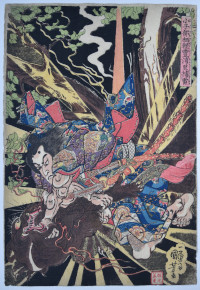
Click here to view image full size.
Koshibe no Sugaru amidst a thunderbolt and lightning captures a raiju (thunder monster) in the village of Toyora. Toyora no sato ni rai o torau. Its body was composed of lightning and usually in the form of a wolf or dog. Its cry sounded like thunder. Raiju is the companion of Raijin, the Shinto god of lightning. Although normally tranquil, during thunderstorms it became agitated and attacked trees. (Those that are struck by lightning are said to have been scratched by Raiju’s claws.) He presented it to the Emperor. Published by Nishimura-ya Yohachi, c. 1834-5. Robinson SIc.2. A wonderful design.
Superb impression. Very fine colour and condition. Signed Ichiyusai Kuniyoshi ga.
Status: Sold
Utagawa KUNIYOSHI (1797-1861)

Click here to view image full size.
Shows Matsuura Sayohime at the top of Kagami Mountain at Matsuura sadly watching her departing husband, Otomo no Sadehiko, on his way to Korea. It’s told she prayed with such fervour that she was turned to stone. From the set Kenjo reppuden, “Stories of Wise and Virtuous Women.” Published by Ibaya Sensaburo, 1841-2.
Very fine impression, colour and condition. Signed Ichiyusai Kuniyoshi ga.
Status: Sold
Utagawa KUNIYOSHI (1797-1861)

Click here to view image full size.
Kaneko Kugutsune (aka Okane, Kane-jo, and Omi no Okane) from the set Chuko meiyo kijin den, “Stories of Remarkable Persons of Loyalty and High Reputation.” Published by Iseya Ichiemon or Enshuya Matabei (this design) 1845. Robinson S35.5. Known as the Strong Woman of Omi, she is credited with subduing a runaway horse by holding its rein down with her geta. She is shown here with her washtub, the wild horse in the background.
Superb impression and colour. Very slight crinkling , trimmed close and some small wormage, otherwise fine condition. Signed Cho-o-ro Kuniyoshi ga.
Status: Sold
Utagawa KUNIYOSHI (1797-1861)

Click here to view image full size.
Musashi-bo Benkei of herculean strength subdued by the young Onzoshi Ushiwaka Maru (Yoshitsune) on Gojo Bridge. The story relates how Benkei (1155-1189) wandered around Kyoto with the intention of relieving 1000 samurai of their swords. One night with one more sword to go he saw Yoshitsune playing a flute and wearing a golden sword at the Gojotenjin Shrine. They agreed to fight on Gojo Bridge in southern Kyoto. However, Yoshitsune was too agile for Benkei and had been educated in the secrets of fighting by the tengu. Following Yoshitsune’s victory Benkei became Yoshitsune’s retainer. Published by Tsutaya Kichizo, c. 1843.
Fine impression and colour. Slight trimming, otherwise very good condition. Signed Ichiyusai Kuniyoshi ga.
Status: Sold
Utagawa KUNIYOSHI (1797-1861)

Click here to view image full size.
The death of the Daimyo Imagawa Yoshimoto (1519-60) by Oda Nobunaga during the battle of Okehazama which was fought at night during an intense downpour and was the culmination of the feud between the Imagawa and Oda clans. The battlefield is now a park and a national historical site. The best design from a set Yobu hakkei, “Military Brilliance of the Eight Views.” Each print relates to the famous Eight Views theme, in this case Narumi yau, “Night Rain at Narumi.” Published by Enshuya Hikobei, 1852.
Fine impression, colour and condition. Full size with extra paper left and top, which is unusual as these prints are normally trimmed from albums. Signed Ichiyusai Kuniyoshi ga.
Status: Sold
Tsukioka YOSHITOSHI (1839-1892)

Click here to view image full size.
“Flood” from a series Seiu kandankei, “A Barometer of Emotions.” Shows Nakamura Shikan III as Abe Bungo no Kami riding his horse through waves. Published by Okura Magobei 1876-77 (this being 1876). A rare set with some striking designs comparing actors in theatrical roles with meteorological phenomena.
Fine impression and colour. Slight trimming, otherwise fine condition. Signed Oju Yoshitoshi hitsu.
Status: Sold
Utagawa KUNIYOSHI (1797-1861)
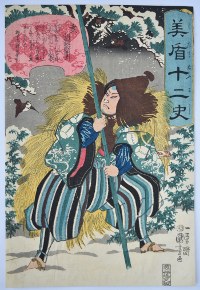
Click here to view image full size.
Yamamoto Kansuke striding through the snow. “Boar” from a set Mitate junishi, “Selection for the Twelve Signs.” Published by Ibaya Kyubei, c 1845. (Kansuke was famous for killing a giant boar in the snow.) Robinson S38.12.
Fine impression, colour and condition. Signed Ichiyusai Kuniyoshi ga.
Status: Sold
